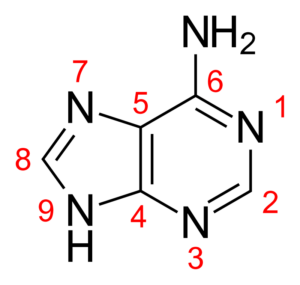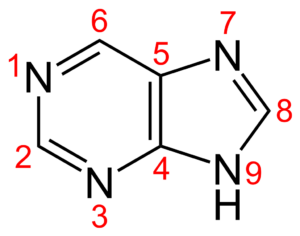Adenine is not a pyrimidine but rather a purine nucleobase i.e. a nitrogenous basic molecule.
One of the most important nucleobases that make up nucleotide structures of nucleotides both in DNA and RNA. Adenine binds in complimentary association to Thymine in DNA or Uracil in RNA and forms a double bond.
So to answer the question “Is Adenine a pyrimidine” we must understand the context of nucleobases purine and pyrimidine.
The tautomer most commonly used in biological explanations is the 9H tautomer. The structure is composed of 2 cyclic C chains- one is a pentamer while the other is a hexamer, but in both some Carbon atoms are replaced by Nitrogen.
All about Adenine:
- Having the chemical formula of C5H5N5, and has a total of 9 membered fused rings.
- Adenine is an organic base.
- It is called a purine base i.e. a heterocyclic molecule composed of Carbon, Hydrogen and Nitrogen primarily.
- Adenine can principally exist in a total of fourteen tautomeric forms.
- Because of its cyclic structure, Adenine is chemically hydrophobic in nature i.e. it repels water.
- Adenine is a constituent molecule in both DNA and RNA nucleotides.
- Adenine compounds include Cobalamin or Vitamin B12 and also Adenosine Triphosphate (ATP) which is considered the main energy currency in most organisms.
- Adenine complimentary binds to Thymine in DNA and Uracil in RNA respectively by a pair of links in both cases.

Image: Wikipedia

Image: Wikipedia
Adenine Biosynthesis:
- Adenine is formed during purine metabolism or breakdown.
- The nucleotide Inosine Monophosphate(IMP) is the initial generating compound for both adenine and guanine.
- Glycine, glutamine, and aspartic acid are among the amino acids that make up IMP.
- The coenzyme tetrahydrofolate, which was itself created from a pre-existing ribose phosphate, is likewise used to make IMP.
Is adenine a purine?
Adenine is in the most definite sense a purine.
Adenine structure is composed of a six-membered ring and a five-membered ring fused together, which is the main basic structure of purines. Adenine is a substituted purine molecule.

Purines are heterocyclic aromatic molecules containing an imidazole ring fused to a pyrimidine ring in its chemical structure, present in nucleic acids- DNA and RNA and also in alkaloids like caffeine in coffee and theophylline in tea.
Adenine has a total of nine atoms in its structure. The two cycles are six and five-membered i.e. a pyrimidine and an imidazole ring respectively. Purine is numbered in an anticlockwise fashion, beginning with the first nitrogen in the six-membered ring. The imidazole ring has a clockwise numbering system.
Purines are found in ATP, GTP, cyclic AMP, NADH, and coenzyme A, among other significant compounds. Although amino and oxo forms prevail in physiological settings, purines have an NH2 group and oxo groups that display keto-enol and amine-imine tautomerism.

Image: Wikipedia
So counting this way we see that N is present in positions 1, 3, 7 and 9 generally. Adenine also has these 4 N atoms along with an extra NH2 group attached to the Carbon atom in position 6 in the pyrimidine ring.
Is adenine a substituted pyrimidine?
In biological terms, Adenine is not a substituted pyrimidine, but rather a substituted purine.
Pyrimidine structure is way more simple consisting of a single six-membered ring, having Nitrogen in the 1 and 3 positions. Adenine, which is a purine, on the other hand, is made up of a pyrimidine ring fused to an imidazole ring.

Image: Wikipedia
Pyrimidine has the chemical formula C4H4N2 and is a heterocyclic aromatic organic molecule. It has a single ring (the pyrimidine ring) containing carbon and nitrogen atoms that alternate. Pyrimidine includes Cytosine(C) and Thymine(T) in DNA and Uracil(U) in place of Thymine in RNA. Even Thiamine or Vitamin B1 is actually a pyrimidine derivative.

Image: Wikipedia
So examples of substituted pyrimidine include- Cytosine, Thymine, Uracil, Thiamine and alloxan among many others.
Also Read:
- Adenine vs thymine
- How is adenine formed
- Is adenine used in dna replication
- Is adenine a nucleotide
- Adenine vs cytosine
- Is adenine sugar

I am Trisha Dey, a postgraduate in Bioinformatics. I pursued my graduate degree in Biochemistry. I love reading .I also have a passion for learning new languages.
Let’s connect through linked in: